The requisite set of skills required to make a great cricketer have changed greatly since Test Cricket's conception in the 1870s.
The sport was much more exclusive in its early days. Not only were there fewer countries involved, but those who made the side tended to be upper-class members of society, who didn't need cricket to provide them with a full-time income. There was subsequently a vast disparity in the quality of players in the games early years.
Nowadays, cricket is much more egalitarian. The game no longer sees players stride out into the middle wearing garb you'd expect to see public school students in. The bats are now bigger, but so are the biceps, as physical condition is not only now more important than when Test Cricket began, but even then it was in the past couple of decades.
In addition to the modernizing of the game, certain aspects of cricket have been ebbing and flowing since it began. The contests between bat and ball, spin and pace, defence and offence, have all fluctuated over the years.
Examining the best player from each decade therefore not only offers insight into the individual player, but the era they played in.
These players are selected solely by their performances during a specific decade. So, for example, Mark Taylor's incredible debut series in 1989, where he made 839 runs to help deliver Australia the Ashes, would not be considered in regards to his standing as one of the best players of the 1990s.
Naturally, this disadvantages some players and benefits others. Kevin Pietersen played his 104 Tests between 2005 and 2014, therefore splitting his career fairly evenly between two decades, and is subsequently disadvantaged by this criteria.
In contrast, Malcolm Marshall's Test career spanned from 1978 to 1991, with the bulk of his matches subsequently coming in the 1980s. The timing of Marshall's career is, therefore, more favourable for this method of selection.
Another note on selection is that ODIs and T20Is are given little weight in influencing the players who are picked. While it can be argued that Test cricket is an entirely different game to what it was in 1877, the fact that ODIs are relatively new in cricket's long and detailed history means that giving them too much emphasis would lead to inconsistencies.
The 1870s:
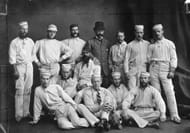
Charles Bannerman (AUS)
Only three Tests were played in the 1870s, with all three being dominated by the bowlers.
With England and Australia being the only two teams to play Test cricket before South Africa's induction in 1889, and with only five players from the two countries having played all three Tests in this decade, there are not many options to choose from.
However, the influence of the greatest player from this decade, Charles Bannerman, should not be underestimated.
The three Tests Bannerman played between 1877 and 1879 were the only three he ever played, but Bannerman's impact was profound.
Statistically, the 1870s remain the least fruitful decade for batting in cricket's history, but Bannerman averaged 59.75. This was largely due to his famed unbeaten 165 in the first Test ever played, where Bannerman not only became the first centurion in Test cricket, but the first Test player to retire hurt.
Remarkably, Bannerman's 165 accounted for 67.35% of the runs in Australia's first innings. No batsman since has scored a higher percentage of his team's runs. The innings that saw Bannerman face the first ever ball in Test cricket, therefore, remains one of the greatest in cricket.
Bannerman's century was the only one in Test Cricket in the 1870s, and the only first-class century Bannerman would score. Yet for that extraordinary innings alone, Bannerman earns his status as one of the most significant players in Test history.
The 1880s:
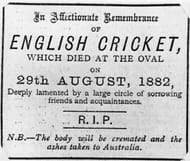
Willie Bates (ENG)
As the frequency of Test matches increased, the first great players began to emerge. WG Grace, Fred Spofforth, George Bonnor, Allan Steel and Johnny Briggs were among those who cemented their place in cricketing history during this decade. But outperforming them all was Willie Bates.
Bates was perhaps not as naturally gifted as some of his counterparts, yet he honed his game to be a deadly off-spinner and a more than useful batsman who occasionally opened for England.
In just 10 years of first-class cricket, Bates accumulated 10249 runs, while also taking 874 wickets. But it was in international games where Bates delivered his best.
Bates played all his 15 Tests in the 1880s, finishing his career with a batting average of 27.33, and a miserly bowling average of 16.42. The likes of Spofforth and Grace may be more celebrated nowadays, but Bates's brilliant record shows that he should at least be considered their equals.
Bates's finest moment came at the MCG in 1883. Batting at nine, Bates made it clear he should be higher up the order as he came in at nine and made 55 to help England reach 294.
Yet it was with the ball that Bates truly shone, as he took seven wickets in each of Australia's innings to consign the home side to an innings defeat. This was no meagre batting line-up either, as Australia's side included the likes of William Murdoch, Alexander Bannerman, George Bonnor and Percy McDonnell.
Bates may have stretched his brilliant performances into further decades if it was not for a terrible accident. While bowling in the nets in Australia he was struck in the eye when a ball he had delivered was forcefully driven back at him. The damage this did to his eye was both profound and permanent, as Bates would never play a first-class game again.
In the aftermath of the accident, Bates would struggle severely with depression. He passed away at just 44, a similar age to when his contemporaries were just calling time on their first-class careers. Yet despite its tragic end, for the years Bates did play, he shone.
The 1890s:
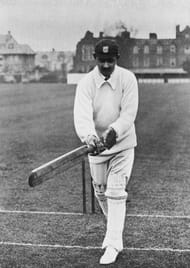
Kumar Shri Ranjitsinhji (ENG)
As the twentieth century dawned, the runs batsmen were scoring began to rise, and few scored runs as freely and elegantly as Kumar Shri Ranjitsinhji.
India wouldn't play their first Test until 1932, yet Ranji, an Indian prince, gave the cricketing world an early taste of what his country of origin would offer the game.
Ranji's technique was unlike anything the game had seen before. He is credited with introducing strokes such as the late cut and the leg glance to the game, shots that now over a century later are commonplace in the game.
Yet unlike other lauded players of his time such as Victor Trumper and Pelham Warner, Ranji had the statistics to support the myth. Ranji only played his first game in the 1890s in 1896, but he made up for lost time by scoring 970 runs at 53.88 in the 12 Tests he played in this decade.
This made him the fourth top scorer of the 1890s with an average comfortably higher than anyone else who played 20 innings during this particular period in time.
Ranji's first-class record is equally as impressive, as he scored 24692 runs at an average of 56.37, including 72 centuries.
While Ranji's career wasn't curtailed as cruelly short as Bates, he was similarly forced to retire because of an injury to his eye. Ranji actually lost his eye in a shooting accident, and though he tried to continue in the first-class arena, he was only a shadow of the batsman he had once been
After Ranji's retirement, Neville Cardus summed up his immense contribution to the game stating that "When Ranji passed out of cricket, a wonder and a glory departed from the game forever."
Ranji would pass away in 1933, India having played their first ever Test just the previous year.
The 1900s:
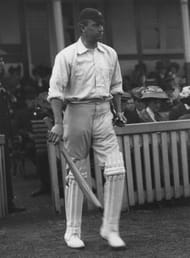
Monty Noble (AUS)
In the 1900s, no player took more Test wickets than Noble's 89, and only three batsmen scored more runs than his 1513.
While the 1980s is generally considered the great era of allrounders, with the likes of Ian Botham, Imran Kahn, Kapil Dev and Richard Hadlee all plying their trade, the 1900s wasn't lacking great allrounders either.
Wilfred Rhodes, Hugh Trumble and Warwick Armstrong were all prolific during this time, but Noble may well have been the most accomplished of them all. This was not only due to his ability with bat and ball but also because of his skill as a fielder and a captain.
At the time Noble played, the captain was largely a political role, where a player's standing in society and ability to give an after-dinner speech was deemed more important than his ability to marshal his players on the field. Yet Noble became known for his strategic innovations, as he would tailor his field to the individual batsmen. This may be commonplace in modern cricket, but for Noble's time, such strategic nuance was rare.
Noble was ahead of his time in other ways too, as he possessed the athleticism that became more and more important as the game progressed. Noble's physicality was supported by a near flawless batting technique and a similarly correct bowling action. He was capable of bowling at a good pace and playing powerful shots, but also had the knowledge to show restraint when necessary.
Throughout the 1900s he averaged 27.70 with the bat, and 25.10 with the ball, bowling more overs in Test cricket than anyone else during this period.
The 1910s:
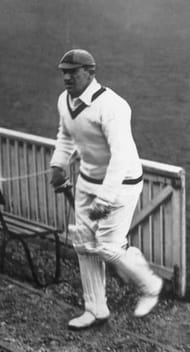
Aubrey Faulkner (SA)
While the First World War saw international cricket go on hiatus for the latter half of the 1910s, there were still many fantastic players who graced the Test cricket arena during this time.
Amongst them were the likes of Jack Hobbs, Frank Woolley, Clem Hill and Sydney Barnes. These are all players still celebrated today, yet none were as important to their countries as Aubrey Faulkner was for South Africa.
Similar to Willie Bates, Faulkner didn't have the obvious talent that other players of his generation possessed. Faulkner began his domestic career as a lower order batsman who would occasionally bowl some medium pace. He was functional, but nothing more.
Yet Faulkner had the fortune of being mentored by Reggie Schwarz, a man who had devised a mythical delivery that would become known as "The Googly". Schwarz taught Faulkner how to bowl his new delivery and subsequently set Faulkner upon the path that would see him become arguably the greatest allrounder in history.
Faulkner's beginnings in Test cricket saw him play mainly as a bowling-allrounder, fooling some of the best batsmen with Schwarz's mystery ball. But come the 1910s, his batting had developed to the point where it perhaps even surpassed his bowling.
The 1910-11 series South Africa played in Australia epitomized this, as Faulkner made 732 runs in five matches against a strong Australian side. Faulkner's batting contributions accounted for 26.34% of South Africa's runs in the series, with no other South African batter managing half his tally.
For much of the early 1910s, Faulkner carried a South African side that was still finding its feet in Test cricket. In this decade, he averaged 50.72 with the bat and 28.62 with the ball.
However, like Bates and Ranji before him, Faulkner's story had a tragic end. He spent what should have been his best cricketing years serving in World War One, where his health suffered after he contracted malaria.
Ill health, and the need to find a steadier source of income than international cricket could offer, meant that Faulkner would only play one Test after World War One. But it was Faulkner's mental health that ultimately cost him the most, as he took his own life in 1930, when not even two decades earlier he had been the greatest cricketer in the world.
The 1920s:
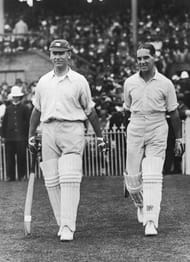
Herbert Sutcliffe (ENG)
The 1920s saw a sharp rise in the runs batters were scoring, as in this decade batsmen averaged 33.25 in Tests, compared to just 26.90 in the 1910s.
England played a big roll in this, as they fielded a particularly strong batting line-up for much of this decade. Their strongest asset was their two openers: Jack Hobbs and Herbert Sutcliffe.
From 1924 to 1930, this pair opened 38 innings for England, with their average opening stand being a phenomenal 87.81. This greatly eclipses the average opening stand of other acclaimed opening pairs. Justin Langer and Matthew Hayden, for example, averaged 51.41, while Gordon Greenidge and Desmond Haynes averaged 46.63.
Hobbs and Sutcliffe's unparalleled record shows them to be the strongest opening partnership Test cricket has seen, by some distance too.
It is no surprise then that the two scored more runs in the 1920s than any other batsmen, with Sutcliffe amassing 2960 at 64.34 over the decade, and Hobbs scoring 2644 at 61.48.
Over this time, Sutcliffe scored 12 Test centuries, and Hobbs 10, when no other batsman managed more than six. They were purely dominant.
Their finest moment as an opening pair was their 283 run partnership against Australia in 1925. This game emphasized their class as they shone, despite the rest of their team struggling greatly. But even with their brilliant first innings partnership and the fact Sutcliffe also made 127 in the second innings, England lost by 81 runs.
Sutcliffe was viewed as a complete batsman. He not only had a flawless technique but was able to adapt his game to make runs on the most difficult of wickets and against the best of bowlers.
While Hobbs could also have been named the finest cricketer of this decade, Sutcliffe's statistics are slightly better than his counterpart. But there is no doubt that neither player can be properly assessed without a particular note being paid to the duo's effectiveness as an opening pair.
The 1930s:
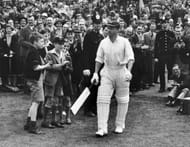
Donald Bradman (AUS)
Not exactly a subversive choice, but it should be recognized that even ignoring Bradman, if that is possible, the 1930s was a decade that saw some brilliant cricketers apply their trade.
Legendary batsmen such as Walter Hammond, Stan McCabe, Leonard Hutton and George Headley all had some of their best years in this decade. Furthermore, it was a strong decade for spin-bowlers, as Clarrie Grimmett, Bill O'Reilly and Hedley Verity all continually vexed batsmen on wickets that allowed for plenty of turn.
There was of course also Les Ames, who can be viewed as the first great keeper-batsman. But the quality of these players, and the fact that Bradman was so far ahead of them all, only emphasizes his superiority.
Throughout the 1930s, Bradman averaged 102.77 and converted 25 fifties into 19 hundreds.
The only series where Bradman was brought down to the level of his counterparts was the 1932-33 Bodyline series. Yet Bradman's statistics in this series were still impressive, as he scored 396 runs at 56.57.
Bradman, therefore, stood well above the rest, but not because the rest were lacking.
Perhaps the person who gets closest to Bradman is George Headley. While some dubbed Headley the black Bradman, the West Indian great preferred to refer to Bradman as the white Headley.
Headley averaged 66.71 throughout the 1930s, yet due to playing for a smaller Test cricketing nation, never played the games he might have if he had been English or Australian. Nevertheless, Headley's average against the English was an impressive 71.23, not too far from Bradman's 89.79.
Yet Headley only averaged 37.33 against Australia, facing bowlers that Bradman never had to.
There's no doubt Bradman was the best, but Headley was perhaps closer to him than his statistics may initially suggest.
The 1940s:
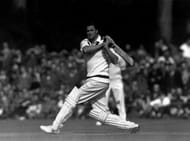
Keith Miller (AUS)
Like the 1910s, the 1940s saw Test cricket go on hiatus due to war. Many of cricket's greatest players had their careers and even their lives cut short.
When Test cricket resumed in 1946, there were many players eager to make up for lost time.
Bradman returned to average even more than he did in the previous decade. Everton Weekes harboured in a new generation of great West Indian batsmen, at one point scoring five consecutive centuries, and Ray Lindwall began his career bowling at paces that had seldom been seen before.
But it was Lindwall's opening bowling partner who seemed most eager to make up for his lost years.
Keith Miller was 26, and possibly in his prime when he made his Test debut, having begun his first-class as a teenager. In only his second game, Miller hit 76 before routing a strong England batting line-up, taking 7/60.
In the 1940s, during which he was part of Australia's famous "Invincibles," Miller was, along with Bradman, the best player in a formidable squad. While Bradman was worth two players due to his batting, Miller was worth two players in that he could make the side for either his batting or bowling alone.
In the 1940s Miller averaged 43.10 with the bat and 20.68 with the ball. But even these impressive statistics don't show the extent of Miller's presence on the field. With the bat, Miller was known as an aggressive stroke-player, someone who could turn a game in a session. He was also capable of generating impressive pace with the ball, forming a mouth-watering partnership with fellow quick Ray Lindwall.
Miller's career would stretch well beyond the 1940s, but he was able to produce his best less and less as the years rolled by. Despite, this, and despite missing some of his best cricketing years to the war, Miller is often viewed as Australia's greatest allrounder ever, even surpassing the likes of Richie Benaud, Alan Davidson and Monty Noble.
West Indies captain John Goddard highlighted Miller's value, saying "Give us Keith Miller and we'll beat the world."
The 1950s:
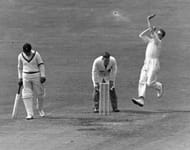
Jim Laker (ENG)
The 1950s had some flamboyant players. The Three W's: Everton Weekes, Frank Worrell and Clyde Walcott ushered in a new generation of West Indies cricket, with Walcott possibly being the greatest batter of the decade.
Ryan Harvey also entertained with the bat, a classical batsman who cricket fans swooned over whenever he took to the crease.
The 1950s also saw Richie Benaud popularize the art of leg-spin, while England also excited with pace, as the likes of Fred Trueman, Brian Statham, Alec Bedser and Frank Tyson terrorized batters at various stages of the decade.
These players all had great records, but one only needed to watch a few balls to see their exceptional talent. It is, therefore, a peculiarity that the most effective player of the 1950s was a tidy off-spinner with an unremarkable action.
At the start of the 1950s, Laker was struggling to cement a place in the England side. His first-class record was impeccable, but in his early Test cricket performances, he was unable to show the full measure of his talent. This was partly due to his own inconsistent performances, and also due to the hesitance of the English selectors to give Laker a prolonged run in the side.
Laker only played a single Test in 1950, and a single Test in 1955, having been selected and dropped several times in between. Yet despite this, Laker was still the second highest wicket-taker of the 1950s after Richie Benaud, taking 162, just behind Benaud's 165. For the last four years of the decade, Laker essentially became the bowling equivalent of Bradman.
Something clicked for Laker. His simple and functional action seemed the same, but the potency of his deliveries changed greatly. From 1956 to 1959, Laker took 107 wickets at just 15.95. To put this in perspective, Australia's great left-arm quick, Alan Davidson, didn't even take that many wickets in the entire decade.
Laker's finest moment was, of course, his 19/90 against Australia. Even today, these are comfortably the best figures a bowler has taken in a single match, both in first-class cricket and in Test. In fact, apart from Laker, only one player has managed to take 17 wickets in a first-class game post World War Two.
Making his figures even more impressive is that in the match before, Laker took 11 wickets, meaning he had taken 30 wickets in two Tests. In the five-match series, no other player managed to take more than 21.
Laker was therefore quick to make up for the early years in the 1950s, as he was peerless for the latter half of the decade.
The 1960s:
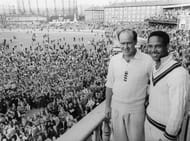
Garfield Sobers (WI)
No side captured the imagination of cricket fans in the 1960s like the West Indies did. In a decade where scoring was often slow and draws were commonplace, the West Indies' aggressive style of cricket provided the perfect antidote.
In their ranks were the likes of Rohan Kanhai, Seymour Nurse, Lance Gibbs and Wes Hall, but despite the talent of these players, none were as prolific as Sobers.
Sobers' Test career would span over 20 years, from 1954 to 1974, so it makes sense that during the 1960s he was in his prime.
Throughout the decade, Sobers scored the fourth most runs of any player, with 4563 at 60.03, and also took the fourth most wickets, with 162 at 32.39.
These were often important wickets too, as the batsmen Sobers dismissed the most were Geoffrey Boycott, and Ken Barrington, who was Sobers closest rival for best batsman of the decade.
Sobers completeness as a player cannot be overstated, as during the 1960s he also took the second most catches, taking 80 in 51 Tests. Furthermore, Sobers bowled pace, finger-spin and wrist-spin at various times, scored a century at every batting position - from opener to seven, and unsurprisingly excelled at many sports apart from cricket.
Sobers peaked in 1966, where he made 895 runs at 99.44 and took 32 wickets at 24.00. He generally scored at a brisk rate and was economical with his bowling, suggesting he would have found further success had he played more of the game's shorter forms.
Outside the 1960s, Sobers still had many great performances, with his world record 365 having come in 1958. Yet for his performances in the 1960s alone, Sobers deserves to be considered one of the greatest players in history, and perhaps even the most complete.
The 1970s:
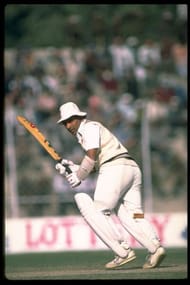
Sunil Gavaskar (IND)
The 1970s saw the Indian Test team take some large strides. Prior to the 1970s, India had never won consecutive series, yet after 1970, they won their first three.
India's improved fortunes were partly down to their exceptional spin duo of Bishan Bedi and Bhagwat Chandrasekhar, but their greatest player during this time was their opening stalwart Sunil Gavaskar.
1971 was Gavaskar's first year in Test cricket, and Gavaskar made it quite clear from the off that he was perfectly at home facing the world's best. Gavaskar finished the year with 918 runs at 83.45. He had set expectations incredibly high for himself, although as the decade rolled on, Gavaskar would continue to fulfil and even surpass expectations, as he would thrice score over a thousand runs in a calendar year.
Over the course of the decade, Gavaskar comfortably outscored all his competitors, making 5647 runs at 55.91.
By the end of the decade, Gavaskar was also India's captain. In the 17 matches that Gavaskar captained in the 1970s, India didn't lose a single time.
It was little surprise that Gavaskar turned out to be a shrewd tactician, as his batting performances commonly showed a mental fortitude and an ability to read the game.
Despite having an array of shots in his arsenal, Gavaskar was selective about when he used them, putting a high price on his wicket. The three double-centuries Gavaskar scored in the 1970s are indicative of this.
While his average dipped slightly, Gavaskar would continue his fine performances into the 1980s, becoming the first player to pass 10,000 runs in Test cricket. He is now just one of 13 players to achieve this feat, but only one of two openers, the other being Alastair Cook.
Gavaskar, therefore, has a strong case to be seen as the greatest opening batsman in history, and an even stronger one to be considered the best player of the 1970s.
The 1980s:
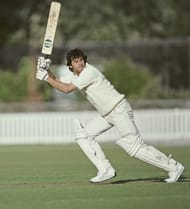
Imran Khan (PAK)
The 1980s was the decade of great allrounders. Ian Botham, Kapil Dev, Richard Hadlee and Imran Khan all played over 50 games in this decade, and all have remarkable figures to show for it.
Richard Hadlee was an immensely skilled bowler who went from a genuine pace bowler to a skilled swing-bowler as the decade progressed. He was at his best in the 1980s, averaging 19.28 with the ball and 30.90 with the bat.
At his peak, Ian Botham was arguably the best of these four, but he was also the most inconsistent. In the 1980s, he averaged 33.75 with the bat, and 32.39 with the ball, fine figures, but that would have been much better if he'd maintained his early Test form.
Kapil Dev was deadly in conditions where pace-bowlers so rarely thrive. He took more wickets than any spinner in the 1980s managed, and did so at an average of 29.54, while also averaging 30.76 with the bat.
All three were the leading Test wicket-takers of all-time at some stage of their careers.
Imran Khan was not, but he was indeed the best of the four during the 1980s. His batting average throughout the decade surpassed his three all-round rivals, standing at 44.18, while his bowling average narrowly bettered Hadlee's, at 19.12.
Khan had superior averages to his peers with both bat and ball.
It is therefore somewhat surprising that Khan's Test career had a somewhat stunted start. Debuting at just 18 in 1971, the pressure was on Khan to lead the next generation of Pakistani cricketers. Yet Khan underwhelmed on debut, and wasn't picked until 1974, where he was once again ineffective.
After three Tests, Khan was dropped once more, not returning until 1976. From there he began slowly to show his worth, although, by the end of the 1970s, Khan had 25 Tests to his name and just one fifty.
However, 1980 was a landmark year for Khan. He made his first century and averaged 31.91 with the bat, while also averaging just 21.47 with the ball. Things would only get better from there, as by the middle of the decade Khan was in one of the greatest patches of form a cricketer has been in.
Khan averaged under 20 with the ball for six consecutive years from 1981 to 1986. Over these six extraordinary years, he took 154 wickets at just 14.85. While his batting was less consistent, he still made some telling contributions, scoring five of his six Test centuries in this decade.
Khan also captained Pakistan for most of the decade, and is still considered by many to be the best captain Pakistan have had. He had strong competition in the 1980s, but that he rose above this competition only highlights his brilliance.
The 1990s:
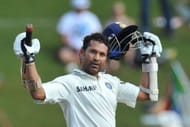
Sachin Tendulkar (IND)
The 1990s was a difficult time for batsmen, as shown by the fact that none of the three highest run scorers in this decade averaged above 42. In a similar vein to the 1980s being the golden era of allrounders, the 1990s was the golden era of pace.
Curtly Ambrose, Glenn McGrath, Wasim Akram, Waqar Younis, Allan Donald and Shaun Pollock were just some of the exceptional fast bowlers to thrive in this decade. If that wasn't enough of a headache for batters, there was also Shane Warn and Muttiah Muralitharan for them to worry about, albeit with the latter yet to reach his prime.
Yet the man who stood taller in the face of these greats than anyone else was the five foot five Sachin Tendulkar.
Still only 16 at the turn of the decade, Tendulkar had already made his Test debut. While he showed he had the head of a much older player, the first few years of the 1990s saw Tendulkar still working hard to find his footing at Test level.
It was in 1992 where things began to fall into place for Tendulkar, as he started the year with an unbeaten 148 against Australia. He would score two more centuries before the year's end, having only reached a hundred once before in his Test career.
In the seven remaining years of the 1990s, Tendulkar averaged over 60 in all but 2 years, scoring a further 16 centuries. His record for the 1990s saw him score 5626 runs at an average of 58.00. Nobody to score 2,000 runs during this period averaged more.
These figures would be incredible for any time, but they are made all the more remarkable by the quality of bowling he faced. This is demonstrated in that no single bowler dismissed him more than 10 times in a Test career that saw him take to the crease 329 times. Tendulkar also adapted his game to suit conditions, as his away average was actually slightly superior to his home one.
With a career spanning 25 years, the 1990s are just one segment of his career, but it was a segment that not only showed he could compete among the best, but that he could be the best.
The 2000s:
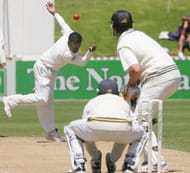
Muttiah Muralitharan (SL)
The 1990s had seen the bowlers wrestle back some power from the batsmen, but the following decade saw this trend reverse in dramatic fashion. In the 1990s, batsmen averaged 31.51, less than any of the previous three decades, but in the 2000s they averaged 34.10, the most since the 1940s.
All the players to score 10,000 or more runs played in this era, except for Sunil Gavaskar and Allan Border. Ricky Ponting almost scored 10,000 in this decade alone, ending with 9458 runs at 58.38.
Jacques Kallis was also brilliant, his 2000s being similar to Sobers' 1960s, as the South African allrounder averaged 58.70 with the bat and 32.00 with the ball.
Among these batting monoliths was Adam Gilchrist, who would come to the crease at number seven and decimate bowling attacks that had often been worn down by the batters above him.
It was quite simply a wretched time to be a bowler, as almost every batting line-up seemed to contain at least one exceptional batsman.
Muralitharan didn't look like the hero the bowlers needed. He didn't have the classic good looks of a Khan or a Miller, nor did he have the obvious athleticism of a Sobers or a Faulkner. Even his action was bizarre, making Laker's seem elegant in comparison. But when the ball left his hand it was pure magic.
Over the course of the decade, 565 batsmen were trapped under Murali's spell, with no other bowler taking 400 wickets during this time. Muralitharan's statistics for this time look like bizarre typos, as they simply don't match up with the rest of the game.
He took 49 five-fors in this period, more than twice the next best. Even more impressive was his 20 ten-fors, with Warne taking the second most of the 2000s with just six. Muralitharan took five in 2006 alone.
There were times when Muralitharan carried the Sri Lankan bowling attack, and times when he was the Sri Lankan bowling attack.
In the 2000s, Muralitharan didn't just defy some incredible batsmen, he defied logic.
The 2010s:
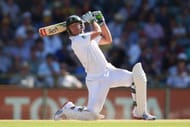
AB de Villiers (SA)
The 2010s have been fiercely contested. Australia's dominance in Test cricket has ended, just as the West Indies did before them. But if one team has taken over Australia's mantle, it has been South Africa.
When South Africa started to become a genuine force in the mid-2000s, it was the likes of Jacques Kallis and Graeme Smith who led the way. But as their influence waned, AB de Villiers, Hashim Amla and Dale Steyn began to prosper.
Steyn is one of the few bowlers to contend for the best player of the 2010s, as it has seen the batsmen continue to dominate the bowlers, even if not quite to the same extent as in the 2000s.
There are plenty of batters in contention, however. Sangakkara played some of his best innings in this decade, but retired in 2015. Steve Smith has a superb average of 61.37, but also oversaw one of the lowest moments in Australian cricket, and suffers as a result. Virat Kohli has now converted his ODI skills to the Test arena, and by the end of the decade may well be the best.
But AB de Villiers' 5059 runs in this period, his average of 57.48, his freakish fielding, and his ability to make even the best of bowlers look like junior cricketers sees him edge his competition.
It is strange to think that at the start of his Test career de Villiers was something of a frustrating talent. Where Graeme Smith made mountains of runs with a technique that was no more than serviceable, de Villiers could play every shot in the book and then a few more, yet was a precarious talent.
It didn't help that South Africa constantly went back and forth on their decision to give de Villiers the keeping gloves, and that he was frequently hampered by injuries. But by the late 2000s, de Villiers seemed to have his game sorted, and by the 2010s he was among the very best.
de Villiers is likely even better than his record suggests, as South Africa tends to be one of the few countries where conditions favour the bowlers. This is reinforced by de Villiers' home average, which is 47.41, some way off his away average of 55.24.
Follow IPL Auction 2025 Live Updates, News & Biddings at Sportskeeda. Get the fastest updates on Mega-Auction and cricket news
